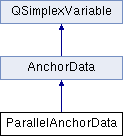 |
Qt 4.8
|
 |
Qt 4.8
|
#include <qgraphicsanchorlayout_p.h>

Public Functions | |
| bool | calculateSizeHints () |
| ParallelAnchorData (AnchorData *first, AnchorData *second) | |
| bool | secondForward () const |
| virtual void | updateChildrenSizes () |
 Public Functions inherited from AnchorData Public Functions inherited from AnchorData | |
| AnchorData () | |
| void | dump (int indent=2) |
| void | refreshSizeHints (const QLayoutStyleInfo *styleInfo=0) |
| QString | toString () const |
| virtual | ~AnchorData () |
 Public Functions inherited from QSimplexVariable Public Functions inherited from QSimplexVariable | |
| QSimplexVariable () | |
Public Variables | |
| AnchorData * | firstEdge |
| QList< QSimplexConstraint * > | m_firstConstraints |
| QList< QSimplexConstraint * > | m_secondConstraints |
| AnchorData * | secondEdge |
 Public Variables inherited from AnchorData Public Variables inherited from AnchorData | |
| uint | dependency: 2 |
| AnchorVertex * | from |
| QGraphicsAnchor * | graphicsAnchor |
| uint | isCenterAnchor: 1 |
| uint | isLayoutAnchor: 1 |
| QGraphicsLayoutItem * | item |
| qreal | maxPrefSize |
| qreal | maxSize |
| qreal | minPrefSize |
| qreal | minSize |
| QString | name |
| uint | orientation: 1 |
| qreal | prefSize |
| qreal | sizeAtMaximum |
| qreal | sizeAtMinimum |
| qreal | sizeAtPreferred |
| AnchorVertex * | to |
| uint | type: 2 |
 Public Variables inherited from QSimplexVariable Public Variables inherited from QSimplexVariable | |
| int | index |
| qreal | result |
Additional Inherited Members | |
 Public Types inherited from AnchorData Public Types inherited from AnchorData | |
| enum | Dependency { Independent = 0, Master, Slave } |
| enum | Type { Normal = 0, Sequential, Parallel } |
Definition at line 210 of file qgraphicsanchorlayout_p.h.
|
inline |
Definition at line 212 of file qgraphicsanchorlayout_p.h.
| bool ParallelAnchorData::calculateSizeHints | ( | ) |
Definition at line 298 of file qgraphicsanchorlayout_p.cpp.
Referenced by QGraphicsAnchorLayoutPrivate::addAnchorMaybeParallel().
|
inline |
Definition at line 234 of file qgraphicsanchorlayout_p.h.
Referenced by QGraphicsAnchorLayoutPrivate::addAnchorMaybeParallel(), and QGraphicsAnchorLayoutPrivate::restoreSimplifiedConstraints().
|
virtual |
Reimplemented from AnchorData.
Definition at line 268 of file qgraphicsanchorlayout_p.cpp.
| AnchorData* ParallelAnchorData::firstEdge |
Definition at line 241 of file qgraphicsanchorlayout_p.h.
Referenced by AnchorData::dump(), QGraphicsAnchorLayoutPrivate::restoreSimplifiedAnchor(), and QGraphicsAnchorLayoutPrivate::restoreSimplifiedConstraints().
| QList<QSimplexConstraint *> ParallelAnchorData::m_firstConstraints |
Definition at line 244 of file qgraphicsanchorlayout_p.h.
Referenced by QGraphicsAnchorLayoutPrivate::addAnchorMaybeParallel(), and QGraphicsAnchorLayoutPrivate::restoreSimplifiedConstraints().
| QList<QSimplexConstraint *> ParallelAnchorData::m_secondConstraints |
Definition at line 245 of file qgraphicsanchorlayout_p.h.
Referenced by QGraphicsAnchorLayoutPrivate::addAnchorMaybeParallel(), and QGraphicsAnchorLayoutPrivate::restoreSimplifiedConstraints().
| AnchorData* ParallelAnchorData::secondEdge |
Definition at line 242 of file qgraphicsanchorlayout_p.h.
Referenced by AnchorData::dump(), QGraphicsAnchorLayoutPrivate::restoreSimplifiedAnchor(), and QGraphicsAnchorLayoutPrivate::restoreSimplifiedConstraints().